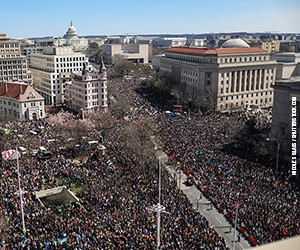Over 80,000 gun enthusiasts and more than 800 exhibitors will descend on Dallas May 4-6, 2018, for the National Rifle Association’s (NRA) Annual Meetings and Exhibits.
President Donald Trump and Vice President Mike Pence will be speaking, and due to their participation at the meeting, firearms, firearm accessories, knives or weapons of any kind are prohibited in the forum during their attendance.
According to the NRA's "Firearms Policy for the NRA Annual Meetings & Exhibits" guns will otherwise be allowed:
During the 2018 NRA Annual Meetings & Exhibits, lawfully carried firearms will be permitted in the Kay Bailey Hutchison Convention Center and the Omni Dallas Hotel in accordance with Texas law.
When carrying your firearm remember to follow all federal, state, and local laws.
[Related Content: MPI Releases Interactive Gun Laws Map]
Whether one is an unapologetic proponent of less regulations for gun ownership or vehemently in favor of stricter regulations regarding firearms, fireworks are sure to fly outside this convention that will serve as the crystallization of one of the most controversial and polarizing issues in the U.S.
It's likely those organizing the NRA’s annual meeting have taken all the necessary steps to keep attendees and the public safe, but what about other groups, not affiliated with the NRA, that will be in Dallas at the same time?
While you might not have your annual meeting or event in Dallas this same weekend, the example should get all planners thinking about how something similar could unfold for one of their meetings in the future.
Imagine that you’re a few weeks out from your event and it comes to your attention that a very controversial, and perhaps much larger, group will be in town the same time. Red flags start popping up everywhere.
Will attendees still feel safe traveling? Will protests make it impossible to get from the meeting to the off-site reception? And most importantly, will your group be safe in the destination?
Steps for Avoiding Conflict at Your Next Event
Joshua L. Grimes, Esq., of Grimes Law Offices shared some steps planners can take to prevent and/or mitigate issues arising from a controversial event being held in the same city or area as their meeting.
1. Other Groups in the Destination: As part of the RFP process, planners should ask hotels, CVBs and the convention center what other meetings they have confirmed on the dates of the smaller meeting. The planner can then research these events to get a sense if they would impact their smaller meeting.
2. Other Groups in Meeting Facilities: Once hotels and venues are selected, the planner should ask about other groups in the properties being used on the dates of the smaller event.
3. Identify Other Large Groups: The planner should ask their hotels and the CVB to notify her or his group if a larger meeting is booked for the same meeting dates. For hotels and venues, this can be included in the meeting contract. The notification request in the contract should not mention "controversial" meetings—that's too hard to define, since an objectionable event to one person may be perfectly acceptable to another.
4. Submitted for Your Approval: Some groups get the right to approve other meetings booked at the same property during the same event dates. This is not a normal concession from hotels, but they might agree if the meeting is off-season, or if the group has particular clout.
5. Mitigate Potential Problems: If it appears that a “problem” event will take place during the time of a planner's meeting, the planner should proactively take steps to minimize the chances for disruption. Steps might include bus transportation instead of walking between venues, holding F&B events on-site at the hotel and extra security. Most of these costs are customarily borne by the smaller group, although a hotel might agree in the event contract to pay costs for extra security if the controversial meeting is also in their property.
6. Force Majeure and Excuse of Performance: With respect to a violent action taking place in the city or at the venue just before the conference starts, this is a contingency that should be covered in the Force Majeure/Excuse of Performance clause in the meeting contract.
Many meeting contracts allow cancellation of an event if it becomes impractical to go forward with it, with “impracticality” defined as a certain percentage of attendees canceling their attendance. But this is a protection that planners must negotiate into a meeting contract; it is rarely a standard provision. A disturbance in the meeting city may not be a force majeure event under the strict definition of that term, but it could be covered under an expanded cancellation clause, often called an “Excuse of Performance” provision.
[Related Content: Disaster Preparedness Q&A With Jonathan Wackrow]
“In terms of differences between these factors and other risks, they are different in that 'controversial' groups are a newer phenomenon,” Grimes said. “A few years ago it was hard to think of instances where attendees would cancel their attendance because of philosophical differences with another group in the same venue, or because another meeting might cause disturbances that couldn't be easily controlled.
"I think the rise in these issues is tied to a lack of tolerance we've seen related to our national and state political activities in recent years," he added. "Attendees are more ready to cancel meeting attendance if they can't make the disagreeable group or activity go away.”
Attendee Safety: A Planner's Obligation
While Grimes’ advice can help planners avoid sharing a venue or even city with what can be considered a controversial group, and what to do about logistics if it does happen, there is still more to think about.
Brenda Rivers, president and CEO of Andavo Meetings & Incentives, explained in an interview with Meetings Today that all meetings have the same responsibilities when it comes to keeping attendees safe.
“To be honest, this is not just about the NRA,” Rivers said. “This is an example of the overall duty of care a meeting planner has for any event. You need to do your investigation and do your research.”
Rivers outlines the four-step process that she believes should be followed and documented to protect an organization from harm to attendees, legal liability or damage to reputation, no matter the meeting size or the organization’s message. Your event doesn't have to be controversial for disaster to strike.
1. Duty to investigate: What is the potential risk of harm to an organization's attendees that could be caused by the controversial subject matter? Is there the likelihood of demonstrators, guns brought into meetings, proximity to potential civil disturbance or inciteful behavior?
Who are your meeting’s resources and responders in case of any disruption or crisis? Hotel security, local law enforcement, hospital, a DMC, etc.? Meet with them in advance and review their emergency protocol.
2. Duty to inform: Advise the meeting organizers and sponsors of the results of the investigation.
3. Duty to recommend: Based on the risk of potential harm, make recommendations that will keep attendees safe. These recommendations should be reasonable and what an experienced and professional meeting planner would know to do. These should not unduly burden the meeting organizer. For example: Hire extra security; a private EMT should be on-call; hire the proper number of meeting staff and train them to handle a crisis.
There is a duty to inform attendees of the risk. This can be done in the mobile app, pre-event FAQs, daily briefing—“be safe, stay safe.”
4. Duty to prepare: Create the meeting crisis response and communication plan. Once you identify the foreseeable risks, develop a written response plan so that your team knows what to do in the first 10 minutes: How to get help from your responders and how to take care of the attendees until help arrives.
Rehearse scenarios, including how to keep the event going after the crisis.
[Read More From Brenda Rivers: Duty of Care Simplified – A Meeting Planner's Guide]







